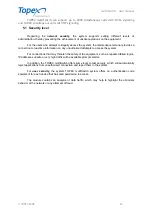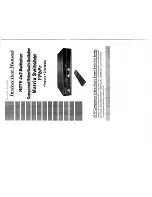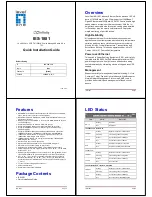
multiSwitch – user manual
© TOPEX 2008 34
7
TEXT FILES CONFIGURATION
TOPEX multiSwitch equipment central application is based on text files which contains the
main parameters of the system. These files are „
.cfg
” type files and can be accessed from the Linux
file structure of the equipment.
7.1 “voip.cfg” configuration
In the “
voip.cfg
” configuration file are set several parameters and protocols referred to VoIP
communication. The location of this file is “
/mnt/app/cfg/voip.cfg
”. In this file can be set the VoIP
protocols, DTMF digits, VAD, codecs.
The main lines of configuration file are:
dtmfRTP 101 100 1
dtmfINFO 1/0
The line includes the DTMF digits according to the RFC 2833 standard and the DTMF digits
sent through INFO signaling.
vad 0
Activation / deactivation of Voice Activity Detection – the process of separating conversational
speech. The primary function of a VAD is to provide an indication of the presence of speech in order to
facilitate speech processing as well as possibly providing delimiters for the beginning and end of a
speech segment.
audio_codecs 18 20 8 20 4 20 0 20
The line above describes the voice codecs used by the equipment and the packets time rate.
Each codec has assigned a standard number. For instance:
18
corresponds to
G.729
8
corresponds to
G.711 A law
4
corresponds to
G.723.1
0
corresponds to
G.711
μ
law
Between the codecs name is included the time rate – the time interval between two voice
packets.
The following lines starting with “voipgw”, “publicvoipgw”, “msp” and “forkmsp” are not used on
multiSwitch.
The last two lines from the “voip.cfg” configuration files are related to H.323 VoIP protocol.
Initially multiSwitch has implemented only SIP protocol. For the H.323 support these two lines must be
activated.
h323 192.168.1.1 9010
forkh323 /mnt/app/bin/h323_apc -p9010
The first line includes the activation command for H.323 VoIP protocol including the IP
address of the equipment and the communication port. The second line runs the core application of
H.323 module.
















































